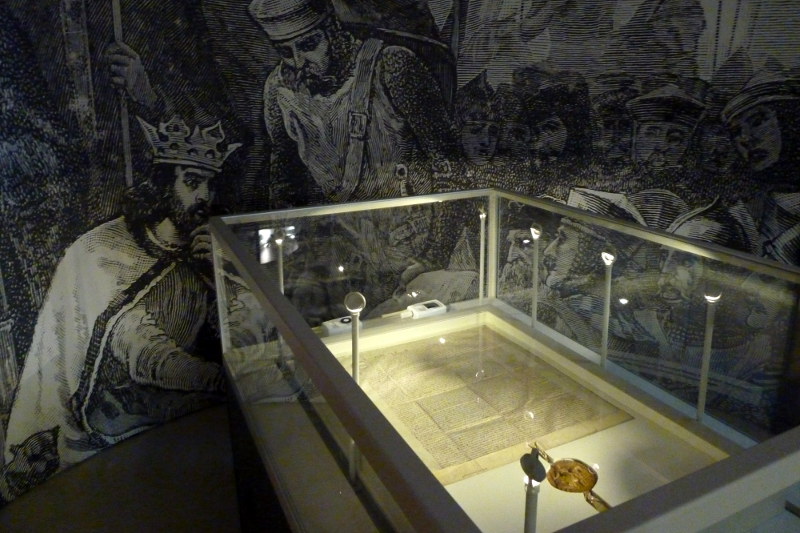It’s hard to believe that a piece of paper written in 1215 would still have an impact on our lives today. But, the laws laid out in King John’s Magna Carta still hold true in Western society.
There were no printing presses or copy machines in the High Middle Ages, so like most important documents from this time, the Magna Carta was copied by hand by a scribe. No one knows how many copies were originally made of the 1215 version, but only four of these still exist today.
I call out “the 1215 version” of the Magna Carta because others were modified and redrafted throughout history. With each new ruler, the Magna Carter was reissued to address the political situation of the time. Of the documents that have an official royal seal, there are the King John, Henry III, and Edward I versions of the Magna Carta.
The one that is on display in Canada is an Edward I version drafted in 1300. Only seven copies of this document survived to today, and the copy on display in Canada is from Durham Cathedral.
The Magna Carta
In 1215 in the UK, King John was extremely unpopular with the landholding barons whom he periodically imprisoned without cause to steal and re-issue their lands.
Women had no rights. People could be imprisoned without cause and held for years without trial. There was no limit on feudal payments or military fealty demanded by King John and to protest meant imprisonment and forfeiture of land. He had absolute power and could do whatever he wanted.
Enter the Magna Carta, first drafted by the Archbishop of Canterbury to make peace between King John and a splinter group of rebel barons who disagreed with the King’s absolute control. The first draft promised protection from illegal imprisonment, a quick trial for those imprisoned, limits on feudal payments, and the formation of a government to uphold these laws.
Even though King John put his official seal on the document, he refused to abide by the conditions within, thus causing the First Baron’s War and subsequent civil wars, which lasted for the remainder of the 13th Century. It was only under the rule of Edward I (1297) that the Magna Carta became a part of England’s statute law.
The 1300 King Edward I version of the Magna Carta states the following (précis version from the marketing materials of the tour):
- Nobody is above the law of the land: The basis of equal justice at all levels of society.
- Habeas Corpus: Freedom from unlawful detention without cause or evidence.
- Trial by jury: Rules to settle disputes between barons and the Crown established trial by a jury of one’s peers.
- Women’s rights: A widow could not be forced to marry and give up her property – a major first step in women’s rights.
The Charter of the Forest
While there are several copies of the Magna Carta in existence, the rarer document is the Charter of the Forest, which was issued in 1217 with the Magna Carta under Henry III’s rule. This is when the “Magna Carta” was given its name, to distinguish the two documents from each other. Until recently, there were only three surviving originals of the Charter of the Forest. In 2015, a “Sandwich” (as in the town) version was found in a cache of crates containing archival materials that were sent to Wales for protection during World War II.
The Magna Carta gave rights to the landholding barons, but the Charter of the Forest gave more universal rights to people living off the land. It also lay the groundwork for the stewardship of shared resources. Until the Charter, people could not use royal lands without huge financial penalties (a major source of revenue for the king). Also, people were not allowed to hunt, fish, harvest, or build on royal land without permission from the King. The penalty for doing so was death.
With the Charter, commoners could “…in his wood or on his land that he has in the forest, may with impunity make a mill, fish-preserve, pond, marl-pit, ditch, or arable in cultivated land outside coverts, provided that no injury is thereby given to any neighbour.” Also, the death penalty was no longer issued as punishment for those caught poaching; instead, those caught faced fines or imprisonment.
The Tour
Both documents came to Canada in June 2015 as part of a tour designed to bring awareness to the impact of the Magna Carta on individual rights, justice and governance in North America.
The Magna Carta and Charter of the Forest are no longer in Toronto. They have moved to Edmonton where they will be on display until December 29, after which both will go back to Durham Cathedral. Durham Cathedral holds three copies of each document (Magna Cartas from 1216, 1225, and 1300 and Charters of the Forest from 1217, 1225, and 1300).
